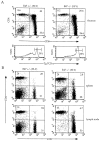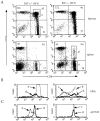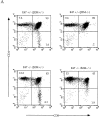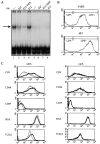Thymocyte maturation is regulated by the activity of the helix-loop-helix protein, E47
- PMID: 10587351
- PMCID: PMC2195738
- DOI: 10.1084/jem.190.11.1605
Thymocyte maturation is regulated by the activity of the helix-loop-helix protein, E47
Abstract
The E2A proteins, E12 and E47, are required for progression through multiple developmental pathways, including early B and T lymphopoiesis. Here, we provide in vitro and in vivo evidence demonstrating that E47 activity regulates double-positive thymocyte maturation. In the absence of E47 activity, positive selection of both major histocompatibility complex (MHC) class I- and class II-restricted T cell receptors (TCRs) is perturbed. Additionally, development of CD8 lineage T cells in an MHC class I-restricted TCR transgenic background is sensitive to the dosage of E47. Mice deficient for E47 display an increase in production of mature CD4 and CD8 lineage T cells. Furthermore, ectopic expression of an E2A inhibitor helix-loop-helix protein, Id3, promotes the in vitro differentiation of an immature T cell line. These results demonstrate that E2A functions as a regulator of thymocyte positive selection.
Figures












Similar articles
-
Early thymocyte development is regulated by modulation of E2A protein activity.J Exp Med. 2001 Sep 17;194(6):733-45. doi: 10.1084/jem.194.6.733. J Exp Med. 2001. PMID: 11560990 Free PMC article.
-
Thymocyte selection is regulated by the helix-loop-helix inhibitor protein, Id3.Immunity. 2000 Jan;12(1):17-26. doi: 10.1016/s1074-7613(00)80155-7. Immunity. 2000. PMID: 10661402
-
The E2A and tal-1 helix-loop-helix proteins associate in vivo and are modulated by Id proteins during interleukin 6-induced myeloid differentiation.Proc Natl Acad Sci U S A. 1994 Jun 21;91(13):5952-6. doi: 10.1073/pnas.91.13.5952. Proc Natl Acad Sci U S A. 1994. PMID: 8016095 Free PMC article.
-
E protein function in lymphocyte development.Annu Rev Immunol. 2002;20:301-22. doi: 10.1146/annurev.immunol.20.092501.162048. Epub 2001 Oct 4. Annu Rev Immunol. 2002. PMID: 11861605 Review.
-
Intertwining proteins in thymocyte development and cancer.Nat Immunol. 2000 Aug;1(2):97-8. doi: 10.1038/77881. Nat Immunol. 2000. PMID: 11248796 Review. No abstract available.
Cited by
-
Helix-Loop-Helix Proteins in Adaptive Immune Development.Front Immunol. 2022 May 12;13:881656. doi: 10.3389/fimmu.2022.881656. eCollection 2022. Front Immunol. 2022. PMID: 35634342 Free PMC article. Review.
-
Id2 and Id3 maintain the regulatory T cell pool to suppress inflammatory disease.Nat Immunol. 2014 Aug;15(8):767-76. doi: 10.1038/ni.2928. Epub 2014 Jun 29. Nat Immunol. 2014. PMID: 24973820 Free PMC article.
-
Stabilization of β-Catenin Directs HEB to Limit Thymic Selection.J Immunol. 2024 Sep 1;213(5):641-650. doi: 10.4049/jimmunol.2400160. J Immunol. 2024. PMID: 38958395 Free PMC article.
-
Gfi/Pag-3/senseless zinc finger proteins: a unifying theme?Mol Cell Biol. 2004 Oct;24(20):8803-12. doi: 10.1128/MCB.24.20.8803-8812.2004. Mol Cell Biol. 2004. PMID: 15456856 Free PMC article. Review. No abstract available.
-
A tamoxifen inducible knock-in allele for investigation of E2A function.BMC Dev Biol. 2009 Oct 12;9:51. doi: 10.1186/1471-213X-9-51. BMC Dev Biol. 2009. PMID: 19822014 Free PMC article.
References
-
- Jameson S., Bevan M. T-cell selection. Curr. Opin. Immunol. 1998;10:214–219. - PubMed
-
- Kisielow P., von Boehmer H. Development and selection of T cellsfacts and puzzles. Adv. Immunol. 1995;58:87–209. - PubMed
-
- Robey E., Fowlkes B. Selective events in T cell development. Annu. Rev. Immunol. 1994;12:675–705. - PubMed
-
- Bain G., Robanus-Maandag E., Izon D., Amsen D., Kruisbeek A., Weintraub B., Krop I., Schlissel M., Feeney A., van Roon M. E2A proteins are required for proper B cell development and initiation of immunoglobulin gene rearrangements. Cell. 1994;79:885–892. - PubMed
-
- Murre C., McCaw P.S., Baltimore D. A new DNA binding and dimerization motif in immunoglobulin enhancer binding, daughterless, MyoD, and myc proteins. Cell. 1989;56:777–783. - PubMed
Publication types
MeSH terms
Substances
LinkOut - more resources
Full Text Sources
Molecular Biology Databases
Research Materials

